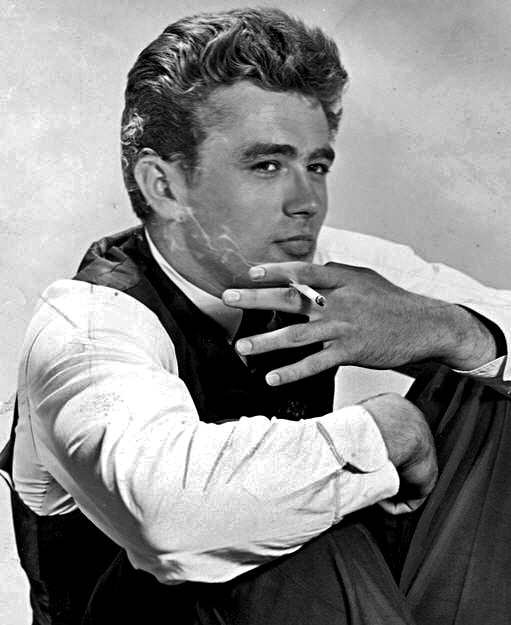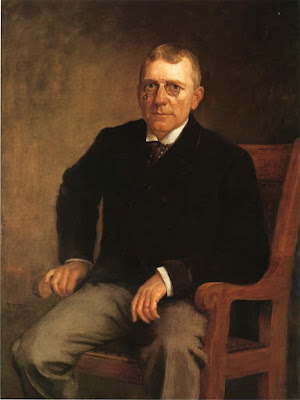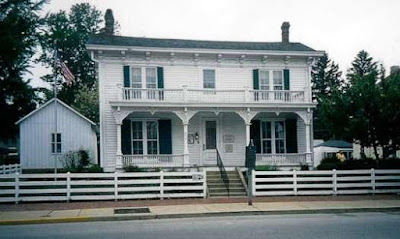It has been 67 years since James Dean died
in a wreck of his sports car on a country
highway near Cholame, California on September 30, 1955.
He was just 24 years old. At the time of his death, he had shot to fame on the strength of one already released film—East of
Eden—and had two more completed
projects in the can, including
the role that would define a generation. On
this slender body of
work rests the fame that has eclipsed most of his contemporaries and endured as a legend.
Today he is a cultural icon that
remains undiminished by
time. Generations of adolescents, whether they know it or
not, do what John Mellencamp described in The Ballad of Jack and Diane, “Scratches
his head and does his best James Dean.”
Dean was born on February 8, 1931in Marion Indiana.
His father was a failed farmer who took up a trade as a dental assistant. The family moved to Santa Monica, California
when he was young. He had a difficult
relationship with his father but was extremely close to his mother. When his mother died when
Dean was 9, he was sent back to Indiana to live in the Quaker home his paternal aunt and uncle in Fairmount.
An unhappy and moody child, he sought council
from a local Methodist minister,
Rev. James DeWeerd, who became a mentor
and substitute father figure.
DeWeerd introduced young Dean to many things beyond their small community
including theater, auto racing, and bullfighting. Some biographers
suggest that this relationship may
eventually have become sexual.
I come upon it suddenly, alone–
A little pathway winding in the weeds
That fringe the roadside; and with dreams my own,
I wander as it leads.
Full wistfully along the slender way,
Through summer tan of freckled shade and shine,
I take the path that leads me as it may–
Its every choice is mine…
Despite
being an indifferent student, Dean
was popular in the local high school and was both an athlete and a participant in drama and forensic competitions. After graduating in 1949 he moved back to
California where he lived with his father and stepmother while attending Santa Monica College with a
declared pre-law major.
He did not last long before transferring to the University of Southern
California (UCLA) where he switched to a drama major, rupturing
his tenuous relationship with his
father.
His talent and ability did not go unnoticed. He quickly earned the coveted
role of Malcolm in a production of Macbeth. He also enrolled in James Whitmore’s
acting studio. In January 1951 Dean dropped out of school to
pursue acting as a career.
He
found it difficult. After a
promising start with a role as the Apostle John in an Easter religious television broadcast, he managed to get just three
walk-ons, unaccredited movie jobs. Dean was parking cars for a living at CBS Studios and virtually homeless when he was noticed
by Rogers Brackett, a radio
director for an advertising agency.
Brackett took him in and mentored his career. Both Brackett and Whitmore
encouraged the young actor to go to New York for stage experience and training.
In the big city, Dean’s career went on the upswing. He made some money testing stunts for the quirky game show Beat the Clock
and was soon getting speaking roles
on various CBS dramatic anthology
series then being presented live
from New York. He followed
in the footsteps of his acting idol Marlin
Brando by gaining admittance to the prestigious Actors Studio
where he studied the Method under legendary teacher Lee Strasberg.
There
were even better roles on Golden Age of Television programs like Studio
One, Lux Video Theater, Kraft Television Theatre,
Hallmark Hall of Fame, You Are There, and Omnibus.
He also found work in ambitious avant-garde
off-Broadway theater productions
including a stage version of Franz Kafka’s Metamorphosis
and a translation of the Greek tragedy Women of Trachis by poet Ezra Pound.
It was
a well reviewed turn on Broadway in
a production of André Gide’s The Imortalist in 1954 that
attracted the attention of Hollywood. At the suggestion of screenwriter Paul Osborn and over the initial objection of the
studio, director Elia Kazan bypassed his close associate Brando to cast Dean
as Cal in John Steinbeck’s East of Eden.
Dean stunned the director and fellow cast members including Jo
Van Fleet, Raymond Massy, and fellow Actors Studio alum Julie
Harris by improvising key bits of business in the
film. The film opened to strong reviews and brisk ticket sales despite the unknown Dean in the lead. The
film went on to win numerous awards
including Best Drama at Cannes and a Golden Globe.
Dean would win a posthumous Academy Award for his role.
On the
strength of reports from the set of East of Eden Warner Bros.
decided to revive a long abandoned project—Rebel Without a Cause
based solely on the title of psychiatrist Robert M. Lindner’s
1944 non-fiction book on criminal pathology. Director Nicholas Ray helped
develop the story of suburban teenage
angst and rebellion. Dean
led the cast as Jim as the troubled lead with Sal Mineo and Natalie
Wood as the outcast members of
his surrogate family.
Dean
was drinking heavily during the
filming and was quickly getting a reputation
for being wild. His fondness
for fast cars and racing enhanced his bad
boy image. He began road racing
sports cars in early 1955 and placed in the top four at several meets. Forbidden to race while
working on his next film, Dean upgraded to a limited edition Porsche 550 Spyder which he had customized and nicknamed The
Little Bastard.
The
next film was Giant an epic, somewhat overwrought multi-generational depiction of a Texas cattle and oil baron’s family based on the book by Edna
Ferber. Dean purposefully chose to play a supporting role to leads Elizabeth Taylor and Rock Hudson
because he wanted to break away from being type cast as sensitive, alienated young
men. Instead, he played Jett Rink, an ignorant hired hand jealous
of Hudson’s wealth and beautiful wife who goes on to become a
successful oil wildcatter and ages into a still resentful, drunken tycoon.
But Dean played the older character as so extravagantly
deranged that it is impossible to believe that he could have won the affections of his
old rival’s daughter. But in Cinemascope
grandeur with three box office
stars, the film was destined to be a hit.
With Giant
going into postproduction, Dean filmed a public service announcement in his Jett Rink cowboy costume advising teenager to drive safely and obey the
speed limit.
On
September 23, Dean proudly showed off The Little Bastard, now decorated with the racing number 130 on the hood, sides, and back to British actor Alec
Guinness who thought it looked sinister,
“If you get in this car,” he told Dean, “You will be dead in a week.”
Exactly seven days
later, on September 30 Dean and his mechanic Rolf Wütherich set
off from Competition Motors, where the Porsche had been readied for on
their way to a race at Salinas. Originally he had planned to trailer the car to the race but decided
that he needed more time behind the wheel to get the feel of the new
car. A crew member and a photographer accompanied the car in
Dean’s station wagon still equipped
with a trailer. Near Mettler Station in Kern County Dean
was ticketed for driving ten miles
an hour over the 55 m.p.h. speed limit.
After that the vehicles became separated.
A few minutes after refueling Dean was headed west on what was then U.S. 45 near
Cholame when a five year old Ford
coupe driven by a 23 year old college student headed in the opposite
direction changed lanes to take a fork in the road and
drove into Dean’s lane. “That guy’s gotta stop,” he told Wütherich,
“He’ll see us.” Seconds later the cars collided nearly head on.
The coupe’s front
grill, riding over the low hood
of the sports car stuck Dean in the head.
He suffered a fractured skull and jaw, a broken neck, and massive
internal injuries. Although still barely breathing when an ambulance
arrived, he died on the way to the hospital.
Wütherich was thrown clear of the car and survived.
The driver of the other vehicle, who claimed never to have seen Dean, suffered minor head injuries and was released un-charged. Despite legends to the contrary, physical evidence showed that Dean was not speeding at the time of the crash.
Dean was buried
by his family at Park Cemetery in Fairmount. Reaction to his death by the public was
sharp and instantaneous.
Like John Dillinger had once recommended, he had “lived hard, died
young, and left a good looking corpse.”
Rebel Without a Cause was released on
October 27. The image of Dean as the rebellious teenager instantly became
inseparable from the actor’s real identity.
Giant was delayed in getting to the screen
by Dean’s death. Some of his dialoged
in his climatic drunken scene was inaudible. Actor Nick Adams had
to be brought in to dub
sections. Other long shots had
to be made with doubles. Still, when that film was released in November
of 1956 it became the biggest grossing
film in Warner’s history and remained so until Superman
twenty-two years later.
Since his death Dean has been the inspiration for imitative performances by generations
of actors, several songs, novels, and even a French language musical. All three of his films are
considered classics and are usually included in round-up of the greatest
American films.
But perhaps nothing says more about Dean’s iconic status more than the 1984 painting by Gottfried Helnwein inspired
by Edward Hopper’s Nightscape. Reproduced as a popular
poster, Helnwein placed a lone James Dean at the front of dark dinner while Marilyn Monroe and
Humphrey Bogart shared a coffee and Elvis Presley cleaned up behind the counter.


.jpg)
















